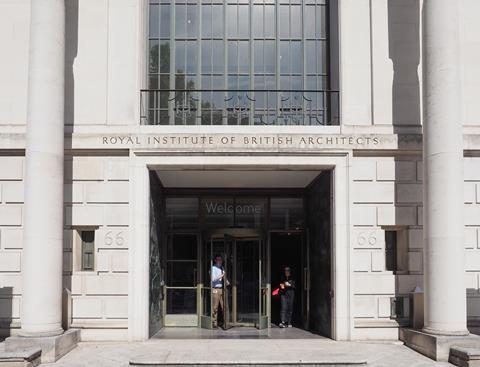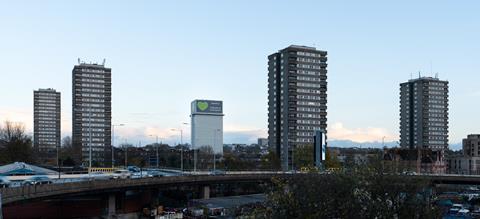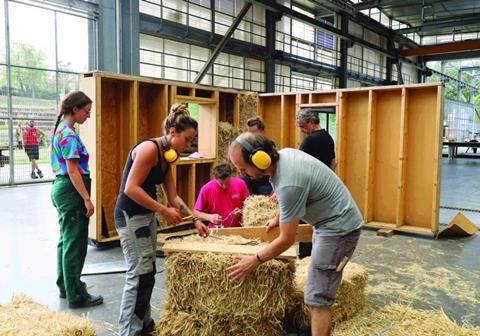Ben Flatman talks to RIBA presidential candidate Funmbi Adeagbo about why the institute matters, the need to address the climate emergency and her own fight to remain in the UK and qualify as an architect

The RIBA presidential elections are upon us once again. The 2022 election saw a practice principal, Jo Bacon, running against a sole practitioner, Sumita Singha, and a salaried architect, Muyiwa Oki. BD wrote at the time that there was “a candidate for everyone in this RIBA election” and exhorted members to “go and vote!”
In the event, turnout actually fell in 2022 to 12.4%, down further from its already dismally low level in 2020, slightly taking the shine off Oki’s otherwise hugely symbolic and widely reported win as the first black man and salaried architect to hold the position.
The seemingly ever-diminishing interest of RIBA members in who heads up the institute has not deterred three more candidates stepping forward this year, with Chris Williamson, Duncan Baker-Brown and Funmbi Olumoroti Adeagbo all in the running to pick up the mantle from Oki in 2025.
Adeagbo is first to be interviewed by BD this time around. On the day BD speaks to her, she is in the midst of not only running her presidential campaign, but refurbishing a house owned by her family.
She is doing much of the work herself, while also managing subcontractors. Her approach to life and architecture is hands on, perhaps reflecting the hard-fought legal battle that she has faced to remain in the UK as an overseas student and secure her professional qualifications.
Adeagbo is currently working as a freelancer, having previously worked at Morris + Company. “Sometimes I call myself a ‘liberated worker’”, she says. “I am freelancing because I’ve got many, many things that I have to be cracking on with that, when you’re in normal practice, you never get the time to do.
“I have actually not taken a break from the profession since I was 17,” she says. “I’ve just gone straight through because I was an immigrant and, with the ever changing immigration law, you just kind of have to keep going because as soon as you stop, they’re like, ‘oh, you’re not doing anything, get out of the country’.
“I had to go to court with the Home Office. They were determined to remove me. In the end I won,” she says. “So it’s always been that you finish work on one job on the Friday and you go straight in to the next one on Monday.”
“So I’m enjoying this time.”
Like Oki in 2022, Adeagbo has the backing of the Just Transition Lobby, which advocates for urgent action on the climate emergency, and better treatment for salaried architects. She is also a current member of the RIBA council, and therefore familiar with the organisation’s structures, and a passionate advocate for RIBA members engaging with their institute.
As someone who has had to fight to remain in the country, and to be able to complete her architectural qualifications, she has a refreshing lack of cynicism about the RIBA and its potential to deliver for its members. Perhaps unsurprisingly, her attitude is also very much that you get out what you put in.
While Adeagbo understands architects’ frustrations at RIBA’s perceived failings, she is also clearly disheartened that more of them are not actively involved and voting. She also believes many architects, put off by the sheer amount of regulatory change, don’t appreciate the support that the institute offers its members.
“There’s a lot that can be gained from your involvement in the RIBA,” she says, pointing out that it provides support for CPD and what she describes as generally “keeping up to date professionally”.
I started getting involved in RIBA more seriously in the last few years because I was looking around and brilliant people were dropping out of the profession
Adeagbo’s references to personal responsibility and agency - as well as social solidarity - are a recurring theme in the interview. “I know membership is a bit pricey,” she tells BD, “but you have a professional licence to maintain that belongs to you. It doesn’t belong to your employer or anybody else.”
Although Adeagbo is passionate about the importance of RIBA’s role, she knows many architects have long been sceptical, and that many are not just leaving the institute, but the profession itself.
“That was the reason I started getting involved in RIBA more seriously in the last few years, because I was looking around and brilliant people were dropping out of the profession. We’re losing so many interesting, good people.”

With turnout at elections so low, why does RIBA appear to be failing to engage with its membership?
“I think RIBA might have a crisis of identity in that the organisation has a lot of drives to improve, such as around EDI, but sometimes the key issues that underlie those things are not really examined.
“So, the question of salaries and fees is something that people shy away from because of fear of being reprimanded due to RIBA being a charity.
“They don’t want to be seen as influencing the market, but at the end of the day, if the RIBA isn’t doing enough to address this issue around fees and salaries, then it’s not really fulfilling its role. So that puts members at a distance.”
She also believes there is still an issue with perceptions of the organisation. “RIBA is still often seen as an old boys’ club,” she explains, “but there are lots of initiatives being steered by young people.
We need to stop this culture of undercutting on fees, because we work in a competitive market and the market will always drop to the lowest common denominator
“People are pouring in their energy, but it’s not being seen as part of the image of the organisation. That image issue needs to be resolved because you’re never going to get people involved if your core image is not resonating with the profession as it is today.”
With many employers constrained over what they can pay their staff due to constantly squeezed fees, what can be done to address these key concerns?
“This issue needs to be tackled in two main ways,” Adeagbo begins. “We need to stop this culture of undercutting on fees, because we work in a competitive market and the market will always drop to the lowest common denominator.
“And then we need to be communicating the value of architects to the rest of our stakeholders. This is something the RIBA can do – we should be shouting very loudly about it.
“We’re specialised professionals. We need to value ourselves and each other within our community.
“Why would you undercut yourself? In the end it’s the person who has the least power that ends up paying the price for this culture. Whether that’s the sole practitioner who feels they have no choice or, in a big practice, the young staff member that can’t say no to working overtime.”
Young salaried architects, feeling underpaid and exploited, often seem to look to the RIBA to act as a sort of trade union on their behalf. At the same time there is a big group of sole practitioners wanting the RIBA to focus on the unregulated architectural designers that compete for small domestic projects, often for rock-bottom fees. And then there are the practice principals of large commercial firms, looking to RIBA to act almost as trade body.
Meanwhile the RIBA charter says its mission is “the general advancement of civil architecture and for promoting and facilitating the acquirement of the knowledge of the various arts and sciences connected therewith”, with no mention of its members, end users, or the environment. Is it perhaps time to rewrite the RIBA charter, clarifying its role and giving it an explicit remit to look out for the interests of its members?
“I don’t think the problem is with the charter. I think the problem is with the assumptions people make about the charter excluding action on certain things.
“Civil architecture for me is about reflecting society. So, the people creating architecture, the people involved in architecture, the community that the architecture serves – they should all be reflected.
“And I think the idea of civil architecture obviously includes the climate emergency, and working conditions. We need to end exploitation of architectural workers – because you can’t have a dead horse pulling a cart, it’s as simple as that.”
What would your priorities be as president?
“I think my priority will be getting consensus on certain topics, so we are agreed on what is good architecture, because good architecture doesn’t exist if it’s not dealing with the climate emergency, or if we are not serving our communities.
We definitely a need a campaign to educate the membership on just what RIBA is about and to educate the public about what architecture’s value is
“The second thing I would improve is communication with members and the public. I think we definitely a need a campaign to educate the membership on just what RIBA is about and to educate the public about what architecture’s value is.
“And then the third thing I would do is really build strong bonds with our international community and address the cultural legacy of the RIBA, opening up conversations so that everybody feels invited.
“We’ve still got under-representation of different skills and different ethnic minority backgrounds within the organisation. I think we struggle to have hard conversations, and to make people feel comfortable being themselves.
“So, the final thing that I would hope to achieve is to open up those conversations – crack it, crack it with a hammer and get that conversation done so that everybody feels like they can learn and grow.”

Following the Grenfell Tower disaster, changes to the regulatory system have seen the introduction of a new principal designer role, intended to ensure clear lines of responsibility for design within the industry. Former RIBA president and current council member Jack Pringle has described it as an opportunity for architects to “get back to conducting the design orchestra”. Do you agree, or is the idea of the architect as lead consultant an idea that has had its time?
“I think the principal designer role is a huge opportunity and a way of demonstrating our competency”, she says.
“But it’s also a challenge for us as a profession because there are many gaps in architectural education and training currently. And, even once you’ve qualified, the industry changes at such a rapid pace. So taking on this role of architect, you constantly need to keep evolving.”
BD recently interviewed Joe Morris, founder of Morris + Company, and he expressed concern that many people had unrealistic expectations of what architects could achieve on their own, in terms of pivoting construction towards a retrofit approach. He pointed out that often clients had made a decision to demolish a building before an architect has even been appointed. What is the future for the retrofit debate?
“I think it’s definitely not an easy thing to grapple with, but being an architect is not easy in the first place. That’s not what you signed up to. You signed up to being in a position of tension in terms of the debate on demolition versus retrofit.
We’ve got a lot of old building stock that was simply built badly that needs to be rectified. You can try and fix it, but sometimes the quickest thing is actually to remove that ‘tumour’
“The issue is that, when you demolish a building, there’s a carbon footprint and the benefits and costs of that should always be at the top of the conversation.
“We should be advocating for retrofit if it’s appropriate. But we’ve also got a lot of old building stock that was simply built badly that needs to be rectified. You can try and fix it, but sometimes the quickest thing is actually to remove that ‘tumour’.”
ARB has proposed major reforms to the UK architectural education system. Are they a step in the right direction?
“I think it’s absolutely important that we’re trying to open up the profession from different angles. I think the traditional method of people coming in purely through an architectural degree means you exclude a lot of very talented people and lose a lot of opportunities for lateral thinking.
“We’ve not really got that porous membrane, and it’s something that needs to be addressed. I think these reforms kind of address that.
>> Also read: Can ARB’s reforms help architecture rebuild its reputation for technical expertise and leadership?
“But I think the main issue with architectural education – which I’m not sure if ARB is really addressing – is its cost and length,” Adeagbo explains. “The professional practice information in the Part 3 course can definitely be taught a lot earlier in the programme, and not just left to the end.
“I also think architects need to get their hands dirty. We need to be thinking more like builders in the sense of assembling things and understanding materials, as well as developing our digital skills.
“We need to be looking at the core structures within education and training to ensure that everybody’s getting those opportunities.

“When I studied architecture in France via Erasmus, I took part in a programme called Grands Ateliers Innovation Architecture, where you actually went into a large hangar and you built one-to-one models in timber and steel.
“And so you start to learn how to detail and add tolerance to what you are designing, which I don’t think gets taught to architects in the UK until something bad happens to them on site. All of these things need to be practically taught from an early stage.”

Are you supportive of the House of Architecture project, the multi-million pound scheme to refurbish RIBA’s Portland Place HQ, and turn it into a national centre for architectural culture?
“I think the House of Architecture project is a funny one in that most of it has to happen. The building needs to be renovated. The building is a bit of a disgrace currently in the sense that this is supposed to be the home of the most prestigious architectural institution in the world, and it’s falling apart.
>> Also read: RIBA launches hotly anticipated £20m contest to redesign HQ
“So, I am supportive, but my main interest in the whole House of Architecture is more the digital side and the archive. From my perspective, that’s the bit that is going to be impactful to members.
“It’s the part that most people will engage in because not everybody’s going to be physically able to get to London and 66 Portland Place.”
How will you connect with members outside of London?
“I think the first means of connection we should be focusing on is the digital connection, because that’s lowest carbon,” Adeagbo explains.
“But I think we need the president of the RIBA to be going around the country speaking to people one-on-one. Obviously, it’s not about getting around for no reason. You have to go to places with a very clear intent of why you’re engaging with them.
“I do think we need to bring the nations and regions tighter into the fold and have them contribute, but also start listening and giving back to them in terms of their contribution because they are paying a membership subscription and they need to see value for that.”
Do you have a final message for RIBA members?
“I think my main message to the RIBA members is to not lose hope due to the changes and disruptions that are taking place in the industry.
“Make sure that you are engaging actively. You will only get something out if you put the effort in and sometimes, even if you put effort in and it has not been rewarded, keep at it. Eventually it will pay off.
“Whatever challenges we are experiencing as an industry, it is important to not give up hope that we have the ability to influence our futures.
“I am very proud of all of the challenges and difficulties I have experienced to get to where I am. I don’t shy away from it all. My scars are there and I hold them as a badge of honour”, Adeagbo says.
“Navigating the immigration system just to get to the point where you’re on the ARB register is exceptionally difficult. I don’t think people understand how difficult it is. And, when you have young people – especially young migrants – coming to the UK, it’s not necessarily about staying in the country. It’s about getting that stamp, that ink on the paper that says you are a British architect.
“And not having that ability, after investing huge sums of money, can be life-changing and traumatising. And so it is not something to make light of – we should recognise that, even if someone is not from this country, they are still a living, breathing human being.
“We should respect everyone that is contributing to the richness of the architecture and community in the UK and internationally.”
















12 Readers' comments